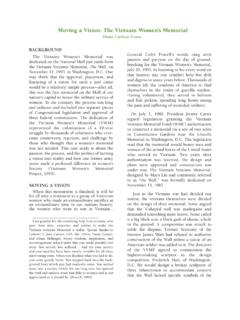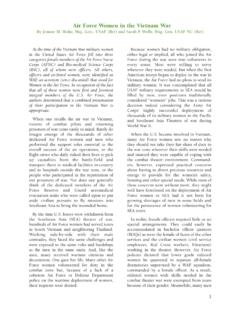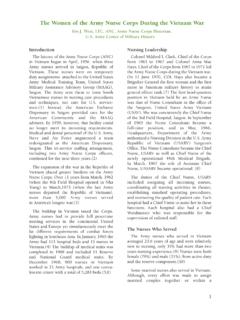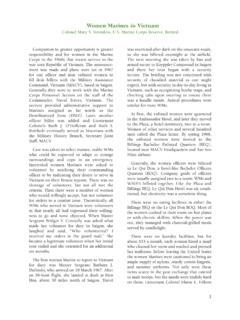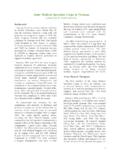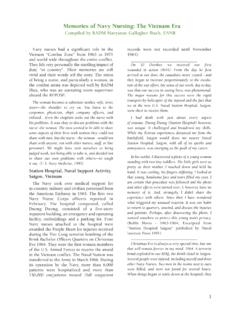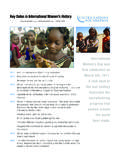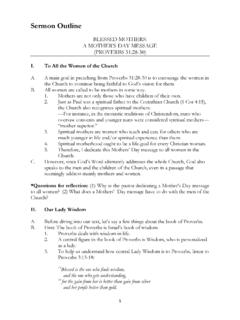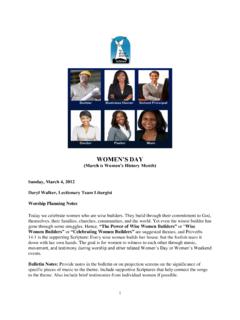Transcription of The Women’s Army Corps during the Vietnam War
1 BackgroundThe women s army Auxiliary Corps wasestablished in May 1942 to increase thestrength of the army to fight World War a year the Corps had 60,000 women the equivalent of approximately 3 divisions performing jobs in administration, communi-cations, and logistics (maintenance, repair andsupply). Congress was impressed with thewomen s contributions and, in 1943, theWomen s army Corps received military Corps reached a peak strength of 100,000officers and enlisted women in April 1944. Afew years after the war, Congress integratedthat WAC into the Regular army of the UnitedStates (1948).
2 Thereafter women in army uniform becamealmost as familiar a sight at the Pentagon, at overseas stations and at posts throughout the United States as army men. Though greatly reduced in strength after World War II, thousands of patriotic young women served in the Corps during the Korean War, the Berlinand Cuban Crises. during these years theCorps averaged approximately 7,000 enlistedwomen and 800 officers. Most of the enlistedwomen served as typists, stenographers,finance clerks, telephone and teletype opera-tors, medical specialists, dental technicians,cryptographers, photographers, and supplyspecialists.
3 WAC officers were assigned to posi-tions in administration, finance, intelligence,signal operations, recruiting, automatic dataprocessing, training, quartermaster, specialservices, publications, legal and civil in VietnamBefore the Pentagon had any requisitions forWomen s army Corps members to serve inVietnam, officers and enlisted women of the Corps were submitting volunteer requeststo serve in Vietnam . Though women were not permitted to serve in combat roles, their duties in past wars in communications, supply, and administration had taken them intoall theaters of 1964, the Commander of MilitaryAssistance Command (MACV), GeneralWilliam C.
4 Westmoreland, asked the Pentagonto provide a WAC officer and noncommis-sioned officer to assist the Republic of Vietnamin organizing and training a women s ArmedForces Corps that would assist the men s Kathleen Wilkes and Sergeant First ClassBetty Adams, seasoned WAC trainers andadministrators, arrived in Saigon in January1965 to begin their duties. When their toursended, they and their successors were promptly replaced by just as competentwomen. Only one WAC officer had served inVietnam up to that time in 1962-63 MajorAnn Marie Doering had been assigned toMACV headquarters as a plans in 1965, General Westmorelandrequested fifteen WAC stenographers forassignment to MACV Headquarters.
5 ThePentagon selected highly qualified and experi-enced noncommissioned officers in the gradeof sergeant and above to fill these positions inSaigon. By June of 1970, over 20 women filledthese special jobs at MACV Headquarters. Theylived in hotels in Saigon. City dwellers wereconstantly harassed by Viet Cong terrorists andthe WACs were no exemption. Their work buswas fire-bombed one morning and its routeoften had to be cleared of anti-personnelbombs. The women worked six-and-seven-dayweeks but after a six month stint they receivedrest and recreation leave at safe distances fromthe Viet 1965 at General Westmoreland s request, adozen WAC officers arrived to fill noncombatpositions at his headquarters and at the newlyestablished headquarters of the ArmyVietnam (USARV).
6 The first officer to arrivewas Major A. Ann Fisher who was assigned tothat headquarters. Some of the WAC of officerswent to the army Central SupportCommand at Qui Nhon and Cam Ranh women s army Corps during the Vietnam War by Colonel (Ret) Bettie J. Morden1 The officers and NCO s assigned to MACVand USARV proved so helpful that the nextyear, General Westmoreland asked for a smalldetachment of WACs primarily clerk-typ-ists to work at HQ, USARV, and other in Vietnam . An advance party ledby Captain Peggy E. Ready and First SergeantMarion C. Crawford arrived in October helped the army engineers arrange thebuildings in which the women were to live atTan Son Nhut Air Base (just outside Saigon)and established the administrative and supplyprocedures for the unit.
7 Early in 1967, approx-imately 80 eager and hard-working enlistedwomen arrived for assignment to the WACD etachment. They were assigned to officesthroughout the headquarters. Like their sisterWACs in Saigon, they worked six-and-seven-day weeks without complaint. Enlisted menassigned to the HQ, USARV, also lived andworked at Tan Son Nhut Air Base. Both themen s and women s quarters and offices wereguarded day and night against attack by VietCong July 1966, the entire USARV commandmoved to Long Binh Post, an army camp builtfor it some 27 miles northeast of Saigon.
8 Life atthis inland post was trying. Red dust coveredeverything and the weather was hot, humid,and uncomfortable. Clothing deterioratedquickly. The women lived four or five to a roomin four two-story buildings that could houseapproximately 130 women . For recreation,they had a patio and swimming pool in theirarea. The pool was donated by the NationalWAC Veterans Association and installed byArmy the adverse conditions and longhours, morale of the women assigned inVietnam remained high because they knewtheir work was important to the success of theArmy in Vietnam .
9 Peak strength of WACsassigned to Vietnam (at any one time) wasreached in January 1970 20 officers and 139enlisted women . The Director of the women sArmy Corps , Colonel Elizabeth P. Hoisington(later Brigadier General) visited the WACs inSaigon and Long Binh in September 1967 andher successor, Brigadier General Mildred , visited the Detachment in March Viet Cong frequently lobbed artilleryshells into the post, aiming at the ammunitiondepot at Long Binh. Though the women werejarred from their beds and suffered scrapes andbruises from flying debris, none was killed norseriously injured in these attacks.
10 Having nocombat training it was stressful for these youngwomen most of them privates first classbetween the ages of 19 to 24 to be exposed toenemy fire. After a few weeks, they becameused to the noise and the racket caused by theshelling and no one asked to be transferred toa safer women were decorated for meritoriousservice while in Vietnam . As merited, theyreceived the Legion of Honor, Bronze StarMedal, army Commendation Medal, AirMedal, Meritorious Service Medal, or JointService Commendation Medal. One officer,Capt. Catherine A. Brajkovich, was decoratedfor heroism for alerting residents of a hotel inSaigon of a fire in the building.
